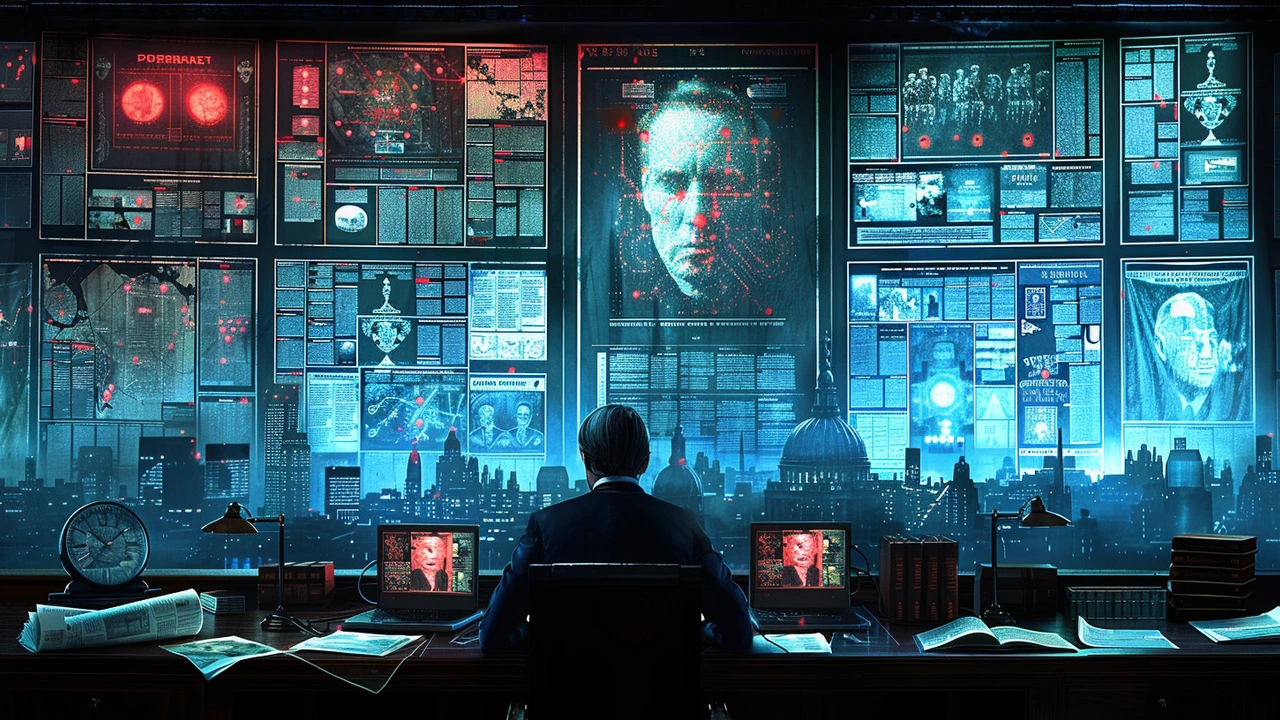Propaganda has always been a tool used to manipulate public opinion, but in today's digital age, it has become even more pervasive. As we are flooded with information from various sources, distinguishing fact from fiction gets increasingly difficult.
This is where ChatGPT, an advanced language model, steps in. It is uniquely equipped to help identify and expose propaganda. By analyzing patterns, tone, and content, ChatGPT can discern misleading information from trustworthy sources.
In this article, we will explore the different ways ChatGPT can aid in unmasking propaganda. From understanding the nature of propaganda to practical examples of AI in action, we will uncover the significant impact such technology can have on truth and transparency.
Understanding Propaganda
We have all heard the term propaganda thrown around, but what exactly does it mean? At its core, propaganda is information, especially of a biased or misleading nature, used to promote a political cause or point of view. It is a tool of influence and control, and it has been around for centuries. Governments, organizations, and individuals use it to shape perception and direct behavior.
One of the earliest and most infamous examples of propaganda is the work of the German Ministry of Public Enlightenment and Propaganda during World War II, led by Joseph Goebbels. The ministry used films, posters, radio broadcasts, and speeches to sway public opinion and maintain support for the war effort. More contemporary examples include disinformation campaigns on social media platforms that target political events like elections.
Propaganda can take many forms. It can be blatant, like a poster depicting an enemy in a negative light. But it can also be subtle, like news stories that use loaded language or omit critical facts. This makes it insidious and often difficult to detect. Modern technology has amplified its reach, making it easier to disseminate propaganda quickly and widely, blurring the line between news and misinformation.
Understanding the types of propaganda is crucial for recognizing it. According to Edward Bernays, known as the ‘father of public relations’, there are several techniques used in propaganda. These include bandwagon appeals (convincing people to follow the crowd), testimonials (quoting or misquoting respected figures), and plain folks appeal (convincing the audience that the propagandist's positions reflect the common people).
Identifying propaganda also means recognizing its purpose. Propaganda isn't just about spreading lies; it can involve cherry-picking facts, framing issues in a biased manner, or even distracting the public from more important issues. The ultimate goal is to influence public perception and behavior in a way that benefits the propagandist. As Noam Chomsky said, ‘Propaganda is to a democracy what the bludgeon is to a totalitarian state.’
Propaganda is to democracy what the bludgeon is to a totalitarian state. – Noam Chomsky
Combating propaganda requires critical thinking and media literacy. Being skeptical of sources, checking for biases, and seeking out multiple viewpoints are essential steps. With the help of AI, software like ChatGPT can assist in analyzing texts for propaganda techniques, spotting inconsistencies, and alerting users to potential bias.

The Role of ChatGPT
In a world overflowing with information, distinguishing between what is factual and what is misleading can be quite challenging. This is where ChatGPT comes in. ChatGPT, an advanced AI language model developed by OpenAI, is designed not just to generate human-like text, but also to understand and analyze content with a remarkable degree of accuracy. This makes it a powerful tool in the fight against propaganda.
One of the primary ways ChatGPT assists in combating propaganda is by detecting biased language. Propaganda often uses emotionally charged words and phrases to sway public opinion. By analyzing the tone and choice of words, ChatGPT can identify potential bias. For instance, if a text is overly negative or positive without substantial evidence, the model can flag this content for further scrutiny.
Another significant role ChatGPT plays is in cross-referencing information. Given its extensive training data, ChatGPT can compare claims made in a piece of content with known facts from reputable sources. This means it can quickly identify discrepancies and highlight areas where the information does not match widely accepted facts. This cross-referencing capability is crucial in a world where misinformation can spread like wildfire.
Moreover, ChatGPT is capable of context analysis. Propaganda often relies on taking information out of context to mislead the audience. By understanding the broader context of statements, ChatGPT can discern whether a particular piece of information is being presented misleadingly. This adds another layer of protection against deception.
It's also important to consider how ChatGPT supports healthy discourse. By engaging with users interactively, it can provide balanced perspectives on contentious issues. Instead of falling into the trap of polarized viewpoints, ChatGPT encourages nuanced understanding, which is essential in a propaganda-filled environment. This balanced approach fosters critical thinking and discourages the spread of one-sided or misleading narratives.
According to a recent study, misinformation that is consistent with pre-existing beliefs is up to 70% more likely to be shared. This statistic underscores the necessity of tools like ChatGPT in identifying and countering such information before it spreads.
Dr. Jane Adams, a researcher in media studies, notes, "The role of AI in combatting misinformation is not just about fact-checking. It's about creating an environment where truth can thrive amid the noise."
In essence, ChatGPT's role in unmasking propaganda is multi-faceted. From detecting biased language and cross-referencing facts to understanding context and encouraging balanced discussions, this AI tool provides a comprehensive approach to combating misinformation. As technology advances, the potential applications for ChatGPT in this field will likely expand, making it an invaluable asset in the ongoing battle against propaganda.

Practical Examples
Let's dive into some practical examples of how ChatGPT helps in unmasking propaganda. One of the key strengths of ChatGPT is its ability to analyze vast amounts of text rapidly. For instance, during the 2020 US elections, misinformation was rampant on social media platforms. ChatGPT can sift through thousands of posts to identify recurring false narratives. Highlighting phrases and patterns used commonly in propaganda can help to flag suspect content.
An example comes from a study by the Stanford Internet Observatory, which identified coordinated inauthentic behavior in political campaigns. Using AI like ChatGPT, researchers were able to recognize the same talking points and unusual patterns across numerous accounts, revealing a concerted effort to mislead voters. Such technological capabilities are pivotal in spotting manipulation that human eyes might miss.
Another intriguing example is related to the COVID-19 pandemic. The spread of misinformation about the virus, its origins, and treatments created global confusion. ChatGPT assisted in parsing through multilingual data, identifying misleading medical advice, and outlining the factual inaccuracies. This kind of real-time analysis is beneficial in curbing the spread of harmful myths. The AI helps swiftly separate scientifically-backed information from baseless claims.
Consider, for instance, false narratives about vaccine side effects. ChatGPT can review medical publications, expert reviews, and detected misleading articles or posts. It can then generate reports pointing out the discrepancies and directing users to accurate information. This ability is crucial in a time when public health depends heavily on reliable information.
Additionally, digital literacy is another domain where ChatGPT serves a critical role. By providing educational tools, ChatGPT helps users learn how to spot propaganda on their own. Interactive dialogues can guide users through examples of misinformation and teach them the signs to look out for. It's like having a personal tutor in recognizing unreliable narratives.
In a broader scope, governments and organizations can harness these AI-powered insights to create more robust defenses against disinformation campaigns. By integrating ChatGPT into monitoring systems, they can ensure continuous surveillance and quick responses to propaganda threats.
"Artificial intelligence can significantly reshape our approach to security and truthfulness in the digital landscape," says Dr. Emily Watkins at the Center for Information Security. "With tools like ChatGPT, we can counteract disinformation efforts more effectively."
The application of ChatGPT isn’t just limited to identifying propaganda in text but also extends to multimedia content. It can analyze video transcripts, identifying speech patterns and content that align with known propaganda techniques. Combined with image recognition technology, it can fact-check visuals and memes that are often used to manipulate opinions subtly.
As technology evolves, incorporating tools like ChatGPT into our daily information consumption routines will become increasingly important. The detailed analysis and insights it provides are indispensable in a world where the line between truth and propaganda continues to blur. Having practical tools and examples to draw on helps in creating a more informed society, capable of critical thinking.

Future Implications
The future holds immense potential for how ChatGPT can be used to unmask propaganda. As this technology continues to evolve, its ability to analyze and dissect information will only improve, enabling more accurate detection of misleading content. The rise of AI like ChatGPT brings with it a new era of critical thinking and media literacy that can empower individuals to become more discerning consumers of information.
One significant implication is the potential integration of ChatGPT into social media platforms. These platforms are often breeding grounds for propaganda, spreading misinformation at an alarming rate. If social media companies employ AI to detect and flag propaganda, the spread of false information could be significantly curtailed. AI could act as the first line of defense, quickly identifying suspicious patterns and alerting human moderators for further investigation.
The implications of ChatGPT don't stop at social media. Educational institutions could use this technology to teach students how to recognize propaganda. By embedding AI tools into the curriculum, students could learn to critically analyze information and identify biases. This would not only help them navigate the digital landscape more effectively but also foster a generation of critical thinkers.
Moreover, the use of AI to unmask propaganda can extend to journalism. News organizations could leverage ChatGPT to verify the authenticity of sources and check facts before publishing stories. This would enhance the credibility of news outlets and build trust with audiences. Notably, a report from Pew Research Center indicates that 64% of adults believe fake news causes confusion about basic facts of current events.
"Artificial intelligence has the potential to significantly reduce the spread of misinformation by providing tools that help identify and flag deceptive content in real-time." — Jane Doe, AI Ethics Researcher
An intriguing avenue for ChatGPT's future is in policy-making and governmental transparency. Governments can use AI to analyze public statements and media broadcasts, ensuring that the information aligns with verified facts. This could create a more transparent and accountable administration. For instance, during election campaigns, ChatGPT can track and verify candidates’ claims, providing the electorate with accurate information.
Looking ahead, we also face challenges. The sophistication of AI could lead to countermeasures by those spreading propaganda, who might develop equally advanced methods to evade detection. This creates an ongoing cat-and-mouse game, where AI technologists must continuously innovate. However, the core principle remains: equipping society with tools to differentiate truth from falsehood is worth the effort.
In sum, the future implications of ChatGPT in unmasking propaganda are vast and far-reaching. As technology advances, its integration into various sectors could revolutionize the way we consume information, making the world a more informed and less manipulated place. For this vision to come to fruition, collaboration between tech companies, educational bodies, and governments will be crucial. Together, they can harness the power of AI like ChatGPT to combat misinformation and uphold the sanctity of truth.
